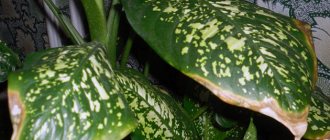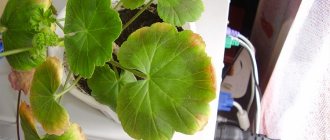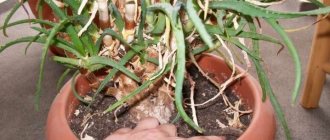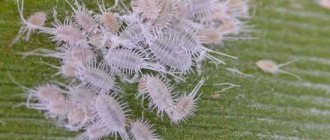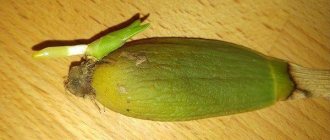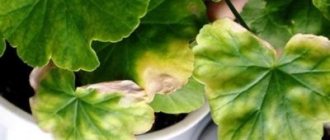Scale insect - a dangerous insect
The small pest is covered with a shield under which thousands of eggs live. Stationary females are tightly attached to the plant with their proboscis and suck out the juices. Males or young individuals migrate, infecting the indoor greenhouse. The shield aphid leaves honeydew - a sweet sticky secretion.
At home, insects breed all year round and do not go into winter dormancy. The appearance of eggs is continuous - 5-6 new generations are formed per year. Colonies quickly destroy indoor flowers.
Peculiarity! Some of the moving larvae (vagrants) enter the apartment with the wind.
Scale insects attack all types of plants, even those that are poisonous to other pests. Favorite species: citrus, palm, bromeliad. Females live equally successfully on orchids, lemons, ficus, ivy, cacti, and crassula.
Kalanchoe leaves dry out and fall off. Problems when growing Kalanchoe
The lush flowering indoor plant Kalanchoe is very popular. The flower is undemanding, has a beautiful appearance and is endowed with healing qualities, which are actively used by traditional healers in the preparation of medicines.
But when growing Kalanchoe, gardeners often encounter serious problems - falling leaves, darkening of the tips of the foliage, the formation of dark spots, etc. All problems, as a rule, are caused by improper care. Although Kalanchoe does not require a scrupulous attitude towards itself, improper care can still cause illness and often the death of the plant.
What to do and how to treat the plant
Saving the plant consists of eliminating yellowed foliage, identifying and eliminating the factors that led Kalanchoe to this condition.
To revive a flower, you must take the following measures:
- provide proper care;
- get rid of pests and pathogenic organisms;
- perform pinching;
- fertilize;
- observe the regime of humidity, temperature and light.
Scale insect and false scale insect
Scale insects belong to the suborder Coccidae and are insects with an oblong two-millimeter body, which is covered on top with a waxy shield. Females are much larger than males and have neither wings nor legs. They sit motionless, covering their eggs. A plant affected by scale insects is covered with a peculiar coating of insects.
The leaves begin to turn yellow and fall off, the growth of Kalanchoe slows down, and flowering stops. The condition of the plant worsens due to additional damage from sooty fungus, which multiplies in the sticky secretion secreted by scale insects. Pests stay mainly on the underside of leaves. Only young larvae are capable of movement; adults are immobile.
Fighting methods
In order to permanently eliminate the cause of crown drying, as well as return the plant to a fresh, healthy appearance and lush green leaves, it is necessary to take some measures to get rid of this problem:
What to do if Kalanchoe drops its leaves?
Proper watering. This is very easy to do, since Kalanchoe is absolutely unpretentious in this matter. It is worth watering the plant if you notice that the soil is dry. Thus, in the hot season, it is worth moisturizing the flower more often than in winter.
Optimal lighting. The plant does not tolerate direct sunlight, so it is necessary to move it away from the window in case of excess light or do the opposite if there is not enough light.
You should not place Kalanchoe close to window glass, as it reflects the sun's rays and can burn the leaves.
Correct temperature conditions and sufficient air humidity. This criterion is especially important, since dry hot air is detrimental to the plant. In summer, the ideal temperature for the plant is 18-20°C, and in winter – 13-16°C. If the air is very dry, you can use special humidifiers or regularly spray the Kalanchoe with a spray bottle.
By following these recommendations, you can quickly cure Kalanchoe, and the plant will again begin to delight with its blooming appearance.
Kalanchoe has been flooded, what should I do? Watering
Kalanchoe is a succulent and is able to accumulate moisture in order to survive dry times.
And if you suddenly forgot to water the plant, then it’s okay. But excessive watering is even harmful to Kalanchoe.
When watering, the water should wet the ground thoroughly, and if there is excess left, it should be drained.
More frequent watering is allowed in the hot season, but also without excess. In winter you need to water twice a week, this will be enough, otherwise there may be rotting of the roots and the appearance of mold and fungus.
If watering is excessive
You can determine that a Kalanchoe plant has been overwatered by paying attention to the leaves:
- they will turn pale and wither,
- dark spots with yellow edges may appear,
- and the ground will always be wet.
Kalanchoe flooding is dangerous because the process of rotting roots occurs at the bottom of the pot, and we do not see it, and the result on the plant itself will be reflected late, when it can no longer be saved.
Why is Kalanchoe Bay possible?
- If you did not replant the plant after purchasing it, the purchased soil may be too moisture-intensive.
- Kalanchoe was transplanted into unsuitable soil.
- Watering too often.
- The pot with the plant is in a too dark or humid room.
- The pot does not have drainage or the pot is too spacious.
Reanimation of a flooded plant
If a flood does occur, you can try to save the plant.
- If the roots are healthy and strong, then replanting is not necessary.
- You can wrap the roots in paper so that it absorbs the liquid well, and change the paper if necessary.
You need to remove the plant from the pot and look at the condition of the roots.
What is a mealybug?
The appearance of this pest cannot be confused with anything. This is a fairly large relative of the scale insect. The mealybug reaches up to 8 mm in length.
Female “hairy lice” have an undeveloped oval-shaped body, more typical of insect larvae. They lay numerous eggs in special sacs in the axils of the leaves. The shoots on which the pest lives are covered with a white, sticky waxy coating.
Males are not at all similar to females - they have wings and normally developed limbs, the body is divided into sections and ends in a bunch of tail filaments
Using their mouthparts, females and larvae easily pierce the surface of a leaf, bud or shoot and suck out the juices from it. Young scale insects are extremely mobile and easily move between plants. Sexually mature males do not feed because their mouthparts atrophy as they grow older.
Why does Kalanchoe have problems with leaves?
- When there is not enough light , the plant stretches upward, so you need to move it to a brighter room or provide lighting. For the same reason, the lower leaves of Kalanchoe turn yellow and their tips dry out, as can be seen in the photo;
- Stagnant indoor air often causes Kalanchoe leaves to fall off. It is necessary to carry out regular ventilation;
- Spots on the leaves can appear from severe crowding, as well as due to sunburn. It is necessary to place the pots at a considerable distance between them and shade them;
- Kalanchoe stops growing and sheds its leaves due to lack of nutrients, especially after flowering. In this case, you need to transplant the plant into nutrient soil or fertilize it;
- If Kalanchoe leaves curl, it means there is a lot of peat in the soil or an excess of nitrogen. You need to transplant the Kalanchoe into a properly prepared substrate, you can read how to do this here.
- Soft leaves of Kalanchoe and their falling may indicate excessive watering or infection with root rot. It is necessary to reduce watering or carry out appropriate treatment of the root system;
- Excessive direct sunlight can cause the Kalanchoe to turn completely yellow;
- If the Kalanchoe dries out or its leaves wither, this indicates a prolonged lack of watering, the presence of pests in the soil or improper soil composition.
Kalanchoe flowers have wilted. Why is Kalanchoe dying? Mistakes in caring for Kalanchoe
Blooming Kalanchoe looks cute and pretty. Many unopened buds promise long-term flowering. You can give such a pot as a gift, or simply please yourself at home. Moreover, it is possible to please yourself and others almost all year round and for a reasonable fee. A small pot with a compact bush can easily be placed on your desktop, on a windowsill or on a shelf. We're talking about Kalanchoe Blossfeld, a common flowering hybrid species of the extensive Kalanchoe genus.
But why does a blooming Kalanchoe suddenly begin to wither, the unopened buds never blooming? Even worse, the leaves become limp and soft, droop and fall off.
As a rule, the main reason always lies in improper watering. Usually the plant is “flooded”, and for this reason the leaves become limp, the flower stalks droop, and dark hard or soft spots of fungal diseases appear on the trunk. The plant dies irrevocably.
Karakay Tatiana / Flickr.com
How to properly water flowering Kalanchoe at home? Kalanchoe is primarily a succulent, that is, it is able to accumulate moisture in its parts, in the leaves and trunk. It must be watered very sparingly, as the soil in the pot dries almost halfway. This plant will not tolerate any heavy watering. Especially if the room is cool. If the room is warm and dry, you will need to water more often. Watch the plant carefully, it will tell you when it wants to be watered. As long as the leaves are dense and the flower stalks stand straight and confident, there is no need to water the Kalanchoe, even if the top layer has dried out. And the concept of “abundant watering” means that you do not water the plant a little every day, without allowing the top layer of soil to dry out, but completely water the entire earthen ball until the water flows out of the drainage holes of the pot. Another suitable watering method for Kalanchoe is to immerse it in a container of water up to the edge of the pot. When all air bubbles disappear from the surface of the container, the pot is removed, excess water flows onto the tray, and then removed from the tray. The watered plant stands on a dry tray.
Along with watering, you need to continue to support flowering using a complex mineral fertilizer for flowering plants, for example “Agricola No. 7”, or any other.
It is not at all necessary to spray the blooming Kalanchoe. Air humidity does not matter for this plant. The degree of illumination is also of great importance for flowering Kalanchoe. In winter it should be a south window and direct sunlight. During the rest of the year, these can be the window sills of the western and eastern windows.
Brenda Dobbs/Flickr.com
Kalanchoe prefers a moderate air temperature in the room, that is, cool, but not lower than 10ºC. The flower behaves well in warm winter apartments at 22-24ºС.
It is also necessary to promptly remove faded flowers along with the peduncles. This can be done with ordinary scissors, which you disinfect and use specifically for caring for plants.
How to make Kalanchoe bloom again? It's not easy at all. This Kalanchoe is originally a species that blooms in spring. Accordingly, when we buy it blooming at other times of the year, we are buying an artificially stimulated and hormone-fed plant that was simply “forced” to bloom for the holidays. Hence all the problems with subsequent development, growth and flowering. In Europe, such plants are treated simply. They are enjoyed during the holidays, and then, when they lose their decorative appearance, they are simply thrown away. This is done with many potted plants that go on sale around the holidays, especially Christmas and New Year. This applies to the Christmas star or poinsettia, begonia, azalea, Kalanchoe and some other plants that bloom out of season or unnaturally abundantly and brightly. But if the gardener’s passion gets the better of you, then you can try to give the plant a second life. First, it needs to be sent for a period of rest. The plant needs to be radically pruned. You need to remove all flower stalks and leaves, leaving just the skeleton of the future bush, consisting of a trunk and a couple of branches. If the remaining parts of the plant begin to dry out and die, cut the Kalanchoe even lower, almost completely, leaving 3-5 cm from the trunk from the soil level. All cuts must be sprinkled with crushed coal. It is best to place the pot in a cool, shaded place with an air temperature of 10 to 16ºC. Watering should be significantly reduced.
Galina / Flickr.com
After a dormant period, the plant needs to be replanted and exposed to intense daylight. You can replant in the same pot where the plant was located. Just change the soil completely. Suitable soil for succulent plants or soil for cacti. A couple of weeks after transplantation, you need to start actively feeding them once every 14 days with mineral fertilizers for indoor flowering plants. And of course, expect a successful result of all your efforts and efforts.
Why do leaves fall on Kalanchoe?
All gardeners want Kalanchoe to always please the eye with green leaves. But it happens that the stem of the plant becomes elongated, and the lower leaves begin to turn yellow and fall off. This behavior indicates improper lighting - there is simply not enough sunlight for him. Sometimes this problem occurs after flowering: growth stops, the flower begins to lose leaves. All this happens when Kalanchoe is depleted. He urgently needs a transplant or good feeding.
Leaves also die during the cold season. This happens due to the proximity to central heating. Most likely, the plant is on a windowsill near the radiator, and the air around it is too dry. Move the flower to a room with a lower temperature. The optimal temperature at this time of year is about 13-15 degrees, then the Kalanchoe will overwinter without loss of green mass. The main thing is that at low temperatures there is no excess moisture, otherwise the plant will have to be treated for mold, which manifests itself in the form of black or brown spots.
In general, when caring for Kalanchoe, it is important to trim old shoots in time, then it will delight you for a long time with its beautiful shape and abundant flowering.
Preventive measures
In order for the Kalanchoe not to get sick and to have a healthy appearance, it is necessary to follow the advice on caring for it and observe the conditions of its maintenance, avoiding drafts, sudden temperature changes, dry air or waterlogging of the soil.
Basically, the prevention of yellowing of leaves is as follows:
- Avoid exposure to sunlight. On sunny days, it is advisable to close the window with a curtain.
- Maintain the correct temperature. In summer - +26...+28°C, in winter - not lower than +15°C.
- Ventilate the room. In this case, drafts should be avoided.
- Develop a watering schedule and strictly adhere to it. In winter - more rare, in summer - generous and frequent. Watering is carried out only with soft, settled water.
- Don't forget about fertilizing. Fertilizers are applied during the growing season in small doses. In winter, the flower is not fertilized.
- Bush formation. Pinch and trim the flower regularly to allow it to develop properly rather than stretch out.
- Inspection for diseases and pests. The sooner a problem is noticed, the faster and easier it will be to get rid of it.
Did you know? In the late 60s, Kalanchoe was recognized as a medicinal plant and today is recommended as an adjuvant to the main course of treatment.
Thus, following planting technology, proper care and proper feeding will help to avoid yellowing of the plant’s leaves and maintain its healthy appearance. And simple preventive measures, carried out in a timely manner, will make growing this flower easier.
Plant value
The plant is valued because it is enriched with extremely useful elements.
In addition to vitamins, microelements, and other valuable substances, flower juice contains:
- flavonoids;
- triterpenoids that inhibit tumor growth;
- bufadienolides, which have antitumor and cardiotonic effects;
- polysaccharides.
Green medicine is valued because its juice can be used immediately, without prior preparation. Can be used for a runny nose, sinusitis, otitis media, eye burns, toothache, and abscesses.
Squeeze the liquid through gauze and immediately drop it into your eyes, nose, and ears. Children need to drop 1-2 drops into each nostril. If the child tolerates it well, then drips should be made every 2 hours. Adults also need to drip into the nose every 2 hours.
After instillation into the nose, severe sneezing may occur. It's okay, that's how the treatment works.
Studies have found that the juice fights staphylococcus and some types of influenza viruses. If you have the flu, you can drop it into your nose and drink 1 tsp of the tincture. a third of a glass of water.
If you are caring for a bedridden patient, then use the nectar of a natural healer to treat bedsores. Bedsores heal even if living tissue dies.
But using fresh nectar can cause a strong burning sensation, so prepare an ointment. Squeeze 30 ml of juice, add 50 g of petroleum jelly and lanolin, stir well. Store the ointment in the refrigerator.
Traditional medicine recommends taking it orally for the treatment of gastritis, tuberculosis, gastrointestinal ulcers, and kidney inflammation. To treat these diseases, a healing elixir prepared from 1 tsp is used. juice to 1/3 cup of water. You should drink twice a day 30 minutes before meals. Course - 3 months. If a person with tuberculosis lives in the house, then drink this remedy for prevention purposes.
Main causes of diseases
Kolanchoe is sick for the following reasons:
- Lack of lighting. Kalanchoe becomes elongated and turns yellow.
- Sunburn or very dense planting. In this case, spotting appears.
- Nutritional deficiency. The flower stops growing and may shed its leaves.
- Excess macronutrients. When a Kalanchoe receives more nitrogen than it needs, its leaves begin to curl.
- Excessive moisture. Leads to acidification of the soil and rotting of the roots.
- Excess sunlight. The plant turns completely yellow.
- The appearance of dry leaves may indicate that the Kalanchoe has not been watered for a long time, the soil has not been selected correctly, or pests have appeared.
Diseases
The cause of flower diseases can be either excessive watering or lack of water.
Kalanchoe, like most fat plants, is unpretentious and ready to grow in a variety of conditions. Flower growers value it for its healing properties and call it a home doctor. And yet, it is also susceptible to disease.
It often starts to hurt from abundant, frequent watering and high soil moisture, but it also happens the other way around.
- Black or brown spots are a fungus. The flower is filled with too much water and mold appears. It is treated by treating with fungicides, changing the place to a warmer and drier one. The number of waterings is reduced.
- Late blight. Externally it appears as brown spots. Appears when there is too much moisture, ventilation is poor and the temperature is below normal. It can also be treated with fungicides and a warm, dry atmosphere.
- Powdery mildew. Very similar to mold, looks like white spots. The reasons are insufficient humidity and high temperature. Treatment consists of normalizing the environment and using fungicides.
- Gray rot. Wet spots of rot with a gray coating. Occurs from dampness, dim lighting, stagnant air. They get rid of the disease by analogy with late blight.
Dampness is the scourge of Kalanchoe. The plant often gets sick from sputum and related factors. Creating conditions for a plant to live is less expensive than treatment, which will take time and effort. The vitality of Kalanchoe is great and it will not succumb to disease. If it dies, it will leave behind offspring that need to be planted in a new pot.
Traditional methods of fighting parasites
Folk remedies will help get rid of scale insects on indoor plants. They are simple, accessible and safe, but are not always effective in cases of large-scale damage. Before using home remedies, be sure to perform mechanical cleaning - this will increase the effectiveness of the procedure.
Folk remedies in the fight against scale insects are presented in the table:
| Means | Cooking method | Application procedure |
| Vinegar | Dissolve 1 tsp. acetic acid in 1 liter of water | Wipe all leaves, sprouts and stems with vinegar solution |
| Washing powder and burdock oil | Add burdock oil and 10 g of washing powder to 1 liter of water. Leave the product for 4 hours | Wipe the leaves with the resulting infusion daily until the pests disappear completely. |
| Pepper | Add 100 g of hot pepper minced in a meat grinder to 2 liters of water and leave for 24 hours | Spray the affected plant generously and repeat the treatment after 10-14 days |
| Alcohol and soap | Mix 1 liter of hot water, 1 tbsp. l. liquid soap and ethyl alcohol. Stir the product until a lush foam forms | Apply the resulting product to places where pests accumulate, and after an hour, rinse with running water. |
| Machine oil and soap | Combine 10 g of liquid soap, 30 ml of water and 10 g of machine oil | Apply the mixture to areas where pests accumulate, and after 12 hours, rinse off in the shower. During processing, cover the soil with polyethylene to avoid contact with the toxic composition. |
| Onion | Chop the onion, add water and leave for several hours | Use the composition to wipe the affected plant |
| Wood ash | Add 300 g of ash to 1 liter of water and boil for 30 minutes. Dilute the finished decoction in 10 liters of water | Use the product to spray the plant after covering the soil with polyethylene |
| Garlic | Chop a few cloves of garlic, add 250 ml of water and leave in a dark place for 6 hours | Moisten a brush or cotton pad in the resulting product and wipe the flower. The composition can be used for spraying, but it must first be filtered through gauze |
Common Pests
- Aphids are the most dangerous enemy of Kalanchoe. Appears mainly in spring. If measures are not taken in time, it will spread to neighboring plants. Aphids are small green or black insects that appear on leaves or stems. She takes the sap of the plant and infects it with her poison. Damaged areas are covered with a sticky substance that prevents the plant from breathing.
At the initial stage, it is difficult to notice the infection, since the insects are very small and settle on the back of the leaf. It can only be detected due to the unhealthy appearance of the plant. It becomes dirty and deformed. To get rid of aphids, you need to trim off the affected areas and burn them. Treat the remaining plant with an insecticide. Repeat once a week for a month. You can also use green potassium soap: dilute it in water and wash the plant with the solution. Can be replaced with laundry soap. Multiclawed mites are small glassy mites. When it appears, the leaves and petioles become covered with brown scabs, and the plant tissues harden and become distorted. Wash off the insects with soapy water and treat the plant with an insecticide.
Scale insects and false scale insects are insects with a two-millimeter body, covered with wax on top. They form a coating (in which sooty fungus is formed) and an accumulation of insects on the plant. The leaves turn yellow, fall off, growth slows down, and flowering stops. For treatment, immediately remove all insects and wash the plant with soapy water. Before removing insects, treat them with alcohol. You can use folk remedies (wipe the plant with a cotton swab and alcohol, use garlic or an old toothbrush).
- Mealybug - an insect that feeds on the sap of Kalanchoe. It propagates the fungus “black mold”. If measures are not taken, the plant will die. The appearance is determined by the appearance of white waxy discharge. For treatment, use mineral oil to spray the leaves.
And this is how leaf diseases and flower pests look in the photo.
Planting and replanting Kalanchoe
A new specimen of a flower culture can appear in our homes through purchase in specialized stores or in the case of donation of a small shoot. In principle, it does not matter at all how the Kalanchoe was acquired; perhaps it is simply time to replant the long-growing flower; it is only important to plant it correctly. The favorable period for planting is, of course, spring. First of all, you need to prepare the soil mixture and container for placing the plant.
The pot should not be too spacious, or you can place several layers at once in one container. As for the filling, the soil for Kalanchoe should be loose; you can prepare the following composition: mix humus, sand, leaf and turf soil in equal parts. You can also find ready-made mixtures designed specifically for succulents. The plant should be handled carefully, as it has rather fragile leaves and stems. A drainage layer is placed at the bottom of the pot, and soil is poured on top to approximately half the volume. Next, the shoot is placed and the remaining soil is added. The pot should be shaken a little to fill the voids and pour plenty of water at room temperature. If the soil has settled significantly, then it is necessary to make another addition.
When buying a flower in a store, you should definitely replant it as soon as possible. After all, on display, plants are in pots filled with transport soil, which contains no nutrients and only flowering stimulants. If you keep the plant in such soil for a long time, this can lead to its death.



